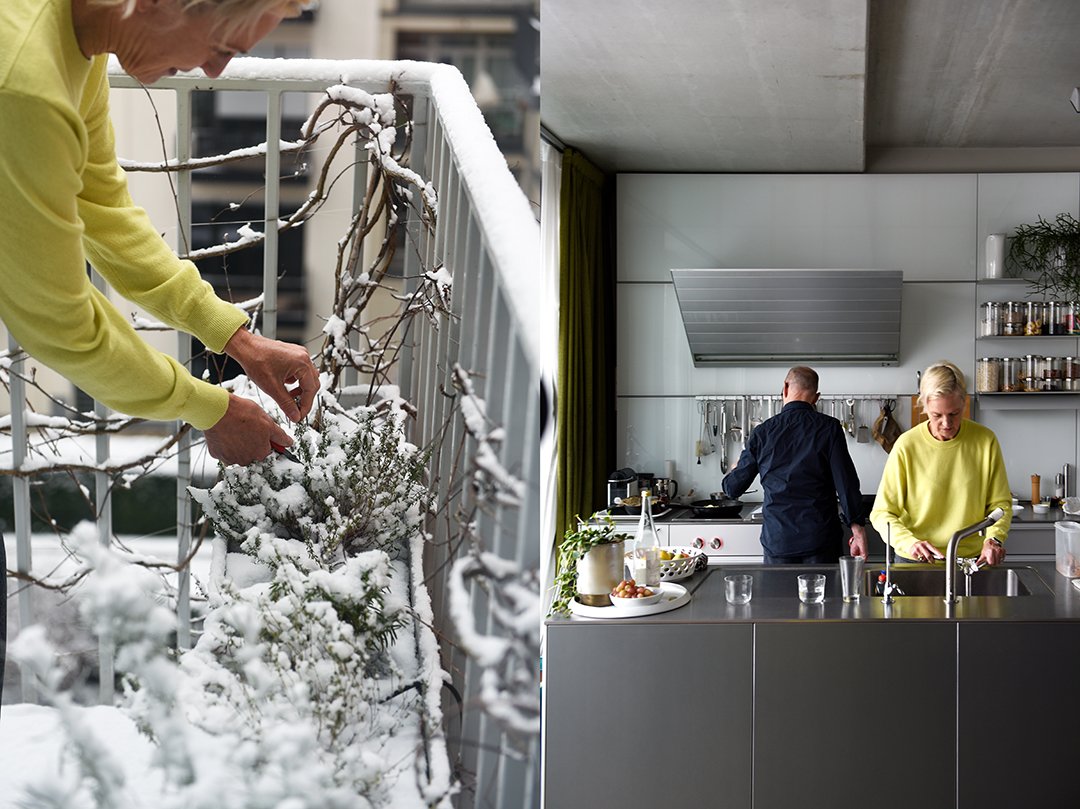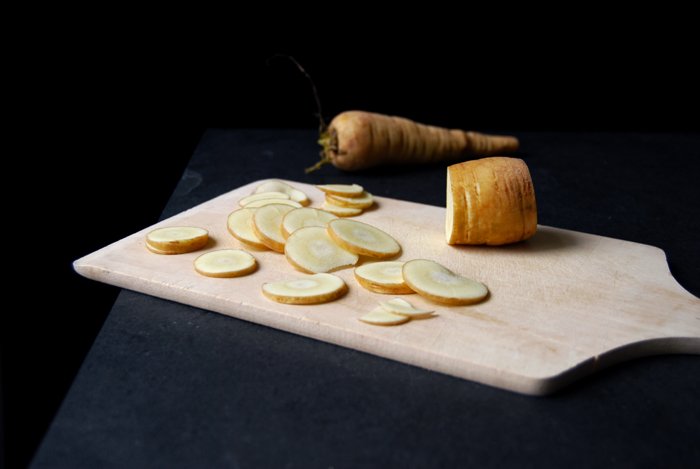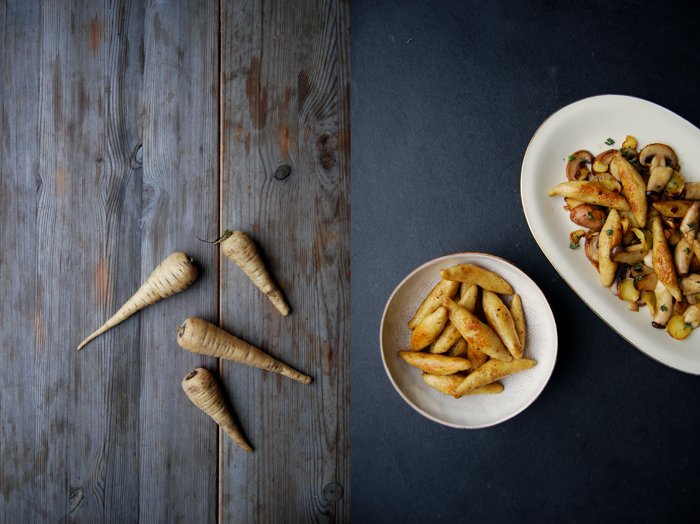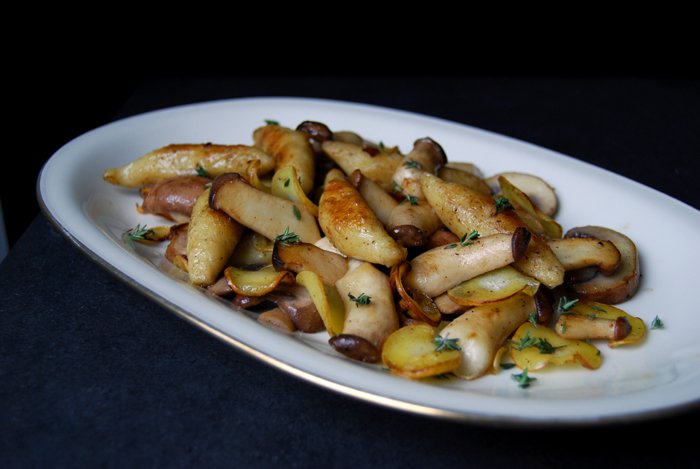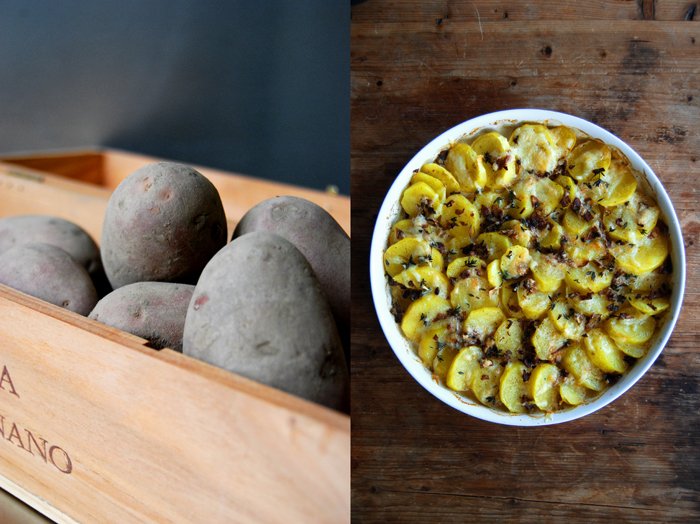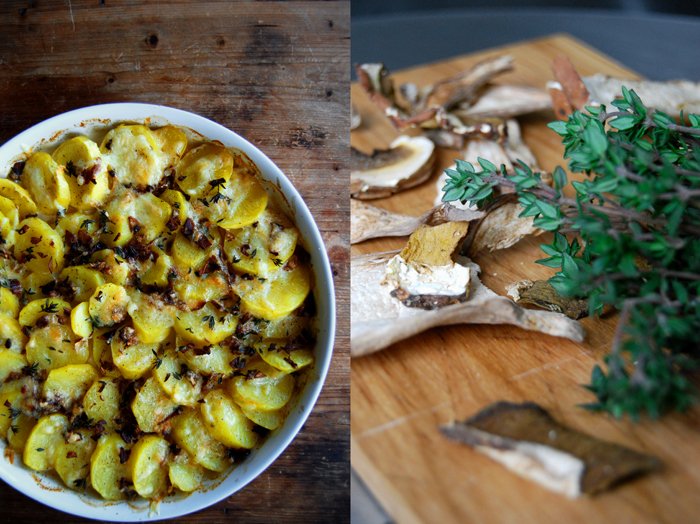Meet In Your Kitchen | Erik Spiekermann's Lemony Mushroom Risotto
This post is part of my Meet in My Kitchen podcast: How did we get to where we are in life & what does food have to do with it
"I’m incredibly chaotic and I’m incredibly precise. When I do work like typesetting and stuff, I’m 100% precise. I do the shittiest detail that nobody would ever know, but I’m also incredibly chaotic in my approach." - Erik Spiekermann
Erik Spiekermann's greatest gift is that he never stopped thinking like a child. He's still driven by the same stubborn persistence, by a tireless curiosity, and the imperturbable will to find out what lies underneath the surface. The acclaimed designer and typographer, responsible for the corporate looks of brands like Audi, Bosch, and Deutsche Bahn, creator of Meta - the Helvetica of the 90s - and the man who decided that the BVG, Berlin's public transportation system, needs to be yellow, is basically still a child, just in the body of a man.
"My curiosity is my biggest feature. I’ve always been curious, so much so that I have been careless. I mean I’ve done things like hitchhike to fucking Norway at 9, which is stupid, it’s the dumbest thing to do if I look back now but I was curious and I was innocent, and innocent and curious are the same. You’re innocent about something so you wanna find out how it works. And I’m still curious and I will try everything because it’s interesting and I think curiosity is one of the greatest human features otherwise we wouldn’t have invented the wheel nor the fire." - Erik Spiekermann
When Erik was nine years old he hitchhiked to Norway on his own. He was part of a Boy Scouts group, his older travel companion didn't show up so he decided to go up north on his own. I asked what his mother said, and Erik's brief answer was "She didn't know, only when I came back weeks later, rather tanned."
As a teenage boy, he was already fascinated by press printing. He got his first printing machine from his father, a mechanic who Erik thinks passed his strong passion for heavy machinery and their mysteries on to him. Whenever he got the chance, he sneaked into a friend's printing firm at night, trying to figure out how all of this works. Setting type and ruining one plate after the other until he internalized the concept - letting any proof of his failed attempts vanish by dawn - but when he finally filled the white pages with his own hands and ideas he was hooked.
Post-war Germany wasn't an easy playing field for a pubescent boy and young man, chances had to be made by yourself and Erik created plenty of them. First in Berlin, then he moved to London in the 60s with his young family, always managing to convince the people around him that he has the ideas that they need.
"We need to make things, we need to touch things with our hands, otherwise we’re gonna become very funny sort of reptiles or robots." - Erik Spiekermann
It only takes a few seconds to understand how Erik always manages to get people's full attention - and their trust. He is very charming but he is also a road roller. For the podcast recording at my place, he ran up the stairs with his racing bicycle on his shoulder (mind he's born 1947), he wasn't out of breath at all but ready to dive into hours of talking about design, life, and food. Erik used to often bake with his mother, never measuring anything, but sensitively adjusting texture, taste, and smell by feeling. Even then he didn't need anyone to tell him what to do, just a mother who taught him to refine his senses and listen to them. He is still very protective of his ideas and visions, fighting for them if need be, summed up in one of his many popular quotes: "Don’t work for assholes. Don’t work with assholes."
After years of designing and teaching, Erik decided to go back to his roots. All his printing equipment burnt in a severe fire in London in the 70s. A painful chapter that he never felt he had closed, a story he still wanted to continue writing, so he founded p98a a few years ago. It's a Berlin based non-profit experimental letterpress workshop stuffed with old equipment dedicated to letters, printing, and papers. Together with a group of designers, he passes his knowledge and skills on to the next generation and enjoys the play of old traditional analogue equipment and new digital technologies. You can order books, or posters and postcards with Erik's quotes and wisdoms, and join workshops with the master himself.
Although Erik would have loved to share his no-recipe-cantuccini recipe with me, I was worried that no one would be in the mood for cookies in January so instead, Erik and his wife, Susanna, shared the recipe for their delicious Lemony Mushroom Risotto with me.
The podcast episode with Erik Spiekermann is in English. You can listen to the Meet in My Kitchen podcast on all common podcast platforms; there are English and German episodes. You can find all the blog posts about these podcast episodes including my guests’ recipes here on the blog under Meet in Your Kitchen.
Listen to the podcast episode with Erik on:
Spotify / Apple / Deezer / Google / Amazon / Podimo
On Instagram you can follow the podcast @meetinmykitchenpodcast!
Mushroom Risotto with Lemon and Thyme
by Susanna and Erik
Serves 4 to 6
For the risotto
Fine sea salt
Olive oil
1 medium onion, finely chopped
420g / 2 cups Carnaroli rice, or Arborio rice
240ml / 1 cup dry white wine
70g / 5 tablespoons unsalted butter
60g / 2 ounces Parmesan, finely grated, plus 30g / 1 ounce for serving
4 tablespoons freshly squeezed lemon juice, plus more to taste
For the mushrooms
450g / 1 pound cremini or white mushrooms, trimmed, torn into bite-size pieces
Freshly ground black pepper
30g / 2 tablespoons unsalted butter
8 medium sprigs fresh thyme
3 small garlic cloves, crushed (optional, Susanna loves it, Erik doesn't)
For the risotto, bring 2.5 liters / 10 1/2 cups of water and 1 tablespoon of salt to a boil in a medium saucepan then remove the pan from the heat, cover, and keep warm.
In a large pan, heat a generous splash of olive oil over medium heat. Add the onion and a pinch of salt and cook, stirring constantly, for about 10 minutes or until golden and soft. Add the rice and cook, stirring, for 5 minutes. Add the wine and let it simmer for a few minutes then add a ladle of the hot salted water, the rice should be covered. Let it simmer very gently and, as soon as the liquid is almost fully absorbed, add more of the salted water. Keep adding a little water at a time, stirring gently once in a while. When the rice is al dente and the liquid is more or less absorbed, you might not need all the salted water, take the pan off the heat, and stir in the butter and Parmesan. Add more of the salted water if the texture isn't creamy (not soupy!) and season to taste with additional salt if necessary. Gently stir in the lemon juice, adding more juice to taste, then cover the pan and set aside.
For the mushrooms, heat a generous splash of olive oil over medium-high heat, briefly cook the mushrooms, stirring occasionally, for 2-3 minutes or until browned and still firm (not mushy!). Season to taste with salt and pepper, add the butter, 6 sprigs of thyme (keeping 2 sprigs for serving), and the garlic then reduce the heat to low and cook for a few minutes until the mushrooms are al dente but not soft.
Divide the risotto and mushrooms among bowls, sprinkle with a little Parmesan, some ground pepper, and the leaves of the remaining 2 thyme sprigs, and enjoy immediately.
Rolled Potato Noodles with Parsnip, King Trumpet & Portobello Mushrooms
Hearty! This word describes best how I feel about this dish, hearty Swabian potato noodles called Schupfnudeln in German (meaning rolled noodles) meet king trumpet and portobello mushrooms sautéed with the thinest slices of parsnip and fresh thyme. This is another one of those dishes that puts me into the mood for a cosy hideaway, a little hut in the forest, lit up with candles and an open fire. I think I need a holiday, each meal I cook at the moment, each ingredient, whatever its origin may be, pulls my mind out of my kitchen into another dreamy scene and they all have one thing in common, silence, peace and seclusion.
As there's nothing planned, I have to take these precious little moments of my imaginary / culinary holidays and rest my mind wherever my kitchen activities may take me. Be it on an imposing mountain top with a sandwich in my hand and the wide horizon right in front of me, or in a wooden hut in the dark forest which calls for a warming soup while I sit on a wooden bench wrapped in warming blankets. I could go on and on, a long walk on a lonely beach and a little crumbly piece of quiche (something I used to do when I lived in Whitby in England), or a paper bag full of fish and chips savoured at the harbour while I watch the fishermen scrub their boats. But I'll stop this now, my real world appetite calls for a real meal and it can't get any better than a plate full of these scrumptious golden Schupfnudeln and Mushrooms!
Schupfnudeln are similar to Italian gnocchi, the dough is a bit more firm and their shape is long. You can eat them straight after being cooked in water but I like to fry mine to golden, buttery bites which puts them right on the next level. They are so good that I always eat more of them than I should, especially in combination with thyme, mushrooms and parsnip, both cooked with a bit of bite, it's too good!
Potato Noodles with Parsnip, King Trumpet and Portobello Mushrooms
For 4-6 people you need
For the potato noodles/ Schupfnudeln
potatoes, cut into cubes, 420g / 15 ounces
butter 1 heaped tablespoon
organic egg yolk 1
plain flour 250g / 9 ounces
nutmeg, freshly grated
salt 2 1/2 teaspoons
pepper
olive oil, to fry the Schupfnudeln
butter 1-2 tablespoons, to fry the Schupfnudeln
Cook the the potatoes in salted water until soft (around 15 minutes). Drain them when they are done. Press the drained potatoes through a potato ricer and mix immediately with the butter and egg yolk. Put in a cool place (in the fridge) until the mixture is completely cool (!).
In a large pot, bring plenty of salted water to the boil.
With a spoon (or your hands), mix the cold potato mixture with the flour, salt, nutmeg and pepper until combined, add more flour if the mixture is too sticky. Dust your hands with flour and take a small walnut sized ball off the dough and roll between your hands to a sausage/ Schupfnudel shape as you can see in the pictures (the ends should be pointy). Keep them on a floured baking sheet.
Cook the Schupfnudeln in batches in the boiling water for 3-4 minutes, when they start to come up and float on the surface take them out with a slotted ladle and put them on a wire rack to cool.
In a large heavy pan, heat a splash of olive oil and the butter and fry the Schupfnudeln until golden on all sides, season with salt and pepper.
For the mushrooms
king trumpet mushrooms, bottom cut off, cut in half (lengthwise), 250g / 9 ounces
portobello mushrooms, bottom cut off, cut into 1/2cm / 1/4" slices, 550g / 1 1/4 pounds
small parsnips, scrubbed and cut into very thin slices, 3
fresh thyme, a few sprigs
olive oil
butter 1-2 tablespoons
salt and pepper
Fry the parsnips in a splash of olive oil on medium-high for about 5 minutes or until golden and al dente, stir constantly. The rim should be light brown but not black!
Heat a splash of olive oil and some butter in a large pan and sauté the king trumpet mushrooms for 1 minute on each side on high temperature, they should be al dente. Season with salt and pepper, add some thyme leaves and take them out of the pan. Keep them on a covered plate while you cook the portobello mushrooms.
In the same pan, heat some more olive oil and butter and sauté the portobello mushrooms for about 2 minutes on each side (also on high temperature). Season with salt and pepper, gently mix with the king trumpet mushrooms, parsnips and some fresh thyme leaves. Serve on a warm plate with the fried Schupfnudeln.
Coq au Vin - a drunken Chicken in Red Wine
A mother's kitchen can be the best cooking class in the world, the place to learn all the little tricks and secrets passed on from one generation to the next. In my mother's kitchen, I learned almost everything I needed to know to become a passionate cook with love and curiosity for ingredients. She nurtured my trust and boldness to create my own cooking style. Her kitchen is still a magic place to me where she creates all these tastes and smells which I'll never forget in my whole life, especially when it comes to meat and gravies cooked the traditional way.
Most of us savoured the first stews and roasts in our mother's and grandmother's creative culinary spaces, where our taste buds were refined to distinguish between the woody herbs like sage, thyme and rosemary and the strong aroma of bay leaf, juniper and allspice. Sauces cooking in pots for hours fogging the kitchen windows on cold November afternoons became more important to me than the meat as this was the spice for my beloved knoedel, mashed potatoes or spaetzle. All the vegetables, spices and green leaves would cook down to a concentrate, the essence of natural, rich flavours, created to soak into the soft sponginess of a slice of soft white bread or a waxy potato mashed into these juices. This was always the pinnacle of cooking to me, an art. My mother, who makes the best sauces I know, would chop and stir for hours to come up with a deep, brown gravy - the grande finale.
For years, Coq au Vin was saved in my mind as one of the time consuming recipes which would take an afternoon of preparation, until I made it myself for the first time. I called my mother twice to double check her recipe and to see that we didn't have any misunderstandings but her recipe was so much easier than expected. It really doesn't take more than 40 minutes to turn a few chicken legs, a bottle of wine, some mushrooms and lots herbs and spices into this amazing French classic. The sauce is so aromatic, it's hard to believe that it wasn't on the cooker for longer. The mushrooms are still crunchy and fresh as they only cook in the juices for the last 10 minutes, some fresh parsley leaves sprinkled on top of the drunken chicken finish it off. Then you can savour the juiciest meat, turned red from the wine and lots of sauce, deep, rich and fragrant.
Coq au Vin
For 4 people you need
chicken legs 5-6 (about 1.5kg / 3.5 pounds)
medium carrots, cut into julienne, 2
large leek, the light part only, cut into julienne, 1/2
bacon, cut into small cubes, 50g / 2 ounces
celery, cut into large pieces, 1 stalk
garlic, crushed, 2 big cloves
small mushrooms (whole not cut!), bottom cut off, 400g / 14 ounces
red wine 1 bottle (0,75l)
olive oil
salt and pepper
parsley leaves, a small handful, for the topping
For the bouquet garni (bound with a cotton string)
parsley, a small bunch
thyme, a small bunch
sage leaves 3
bay leaf 1
In a large pot, heat a splash of olive oil and sauté the chicken legs in batches for a few minutes on each side until golden brown , season with salt and pepper. Set the chicken aside and sauté the bacon for 2 minutes until crisp. Add the carrots, leek, celery and garlic and cook for 2 minutes, stirring constantly. Add the chicken, the bouquet garni and red wine, season with salt and pepper and close with a lid. Cook on medium-low heat (simmering) for 30 minutes.
After half an hour, put the mushrooms on top of the chicken, dip them a little into the juices and cook for 10 minutes. Take out the bouquet garni and celery, season to taste and serve sprinkled with fresh parsley leaves and some crunchy baguette or potatoes.
Spinach Gnocchi with creamy Mushrooms
A homemade gnocchi dinner is quite a satisfying experience on many levels. Let's start with the preparation: it takes a bit longer than cooking spaghetti but it rewards you with the feeling that you've created something special, something pretty and impressive on your plates. Here you don't cook someone else's product in hot water, this is your own dough made with fresh ingredients, gnocchi formed with love and attention. I believe that the effort you put into a meal is saved in it, you can taste it!
Making gnocchi can be intimidating but it doesn't have to be, it's about the right ratio between dry and moist ingredients, and taste obviously. When I make my potato or pumpkin gnocchi I know that I have to follow a few rules. The most important one is not to mix the flour into the vegetable mixture when it's still warm, it has to cool off completely or the gnocchi won't stay in shape. If you think that your dough is too sticky you just add a little more flour until you can hold it in your floured hands. It should feel a bit like yeast dough for pizza, when it's more like glue, impossible to get off your fingers, you have to make some more adjustments. Be brave and it'll work out!
Although my spinach gnocchi are made with fresh breadcrumbs and not potatoes, they follow the same rules. I blanche lots of crunchy winter spinach, squeeze it well and let it cool. Again, if it's too moist and still warm it can cause hassles. Once it's done, I mix it with the bread, a little flour, the spices and parmesan. The green dumplings are very easy to handle, you can even prepare them a few hours ahead before you cook them. I wanted the spinach to come through strong and earthy to keep up with my creamy sauce made of sautéed mushrooms. I also added some salty bacon bits but it's just as good without the smoky flavour, the meat gives it a hearty touch, just choose what you feel like.
When I saw the plate in front of me, a perfect picture of comfortable Italian food, I knew why I don't buy gnocchi from the store. They never taste as good, that's for sure, but they also don't have my kitchen memories saved in every little bite.
Spinach Gnocchi with creamy Mushrooms
For 3-4 people you need
For the mushrooms
mushrooms, the bottom cut off, cut into thick slices, 300g / 10.5 ounces
heavy cream 150-200ml / 5.5-7 ounces
brandy
olive oil
salt and pepper
optional: bacon, cut into small cubes, 60g / 2 ounces
In a large pan, fry the bacon in a little oil for a few minutes on medium heat until golden brown and crisp. Take the bacon out of the pan and add a little more oil if necessary, sauté the mushrooms on high temperature for 1 minute on each side. Deglaze with a splash of brandy, season with salt and pepper to taste and add the cream.
For the gnocchi
fresh spinach leaves (stems cut off), rinsed, 500g / 1 pound
breadcrumbs, freshly ground with a grater or in a food processor, 250g / 9 ounces
organic egg yolks 2
plain flour 70g / 2.5 ounces
Parmesan, freshly grated, 40g / 2 ounces plus more for the topping
salt 1 1/2 teaspoons
nutmeg
pepper
Blanche the spinach in a large pot of boiling, salted water for 1 1/2 minutes. Drain, rinse with cold water and let it cool in a colander for about 10 minutes. Squeeze the spinach in batches in between your hands but mind that it isn't hot anymore. The spinach should be quite dry. Purée the leaves in a food processor and mix with the other ingredients until well combined.
On a well floured surface, roll the dough in batches into a 2cm / 3/4" sausage shape and cut off 3cm / 1 1/4" gnocchi. Spread them on a well floured baking sheet.
In a large pot, bring salted water to the boil and cook the gnocchi in batches on medium heat (simmering). When they start to rise and float on the surface after about 4 minutes take them out with a slotted ladle and drain them for a few seconds. Keep the gnocchi in a covered ovenproof dish in the warm oven (100°C / 210°F) until the last batch is done.
Serve the gnocchi with the mushrooms, sprinkled with freshly grated Parmesan and crushed black peppercorns.
Earthy Porcini Lentil Soup with Honey and Ginger
A couple days ago I ate a very aromatic porcini soup at one of my favourite restaurants and I was very surprised when the chef and owner told me where the mushrooms for this wonderful meal came from, the desert. The dunes of the Kalahari in southern Africa produce sensational truffle and porcini in season from now till May. I savored this dinner together with my family and we were all surprised and impressed at the same time! I've never seen mushrooms from the Kalahari in a store or at the markets before but I will definitely look out for them!
The soup was so tasty that it aroused my appetite for mushrooms and I had to think of a lentil soup my aunt Ursula had told me about (she was at the dinner as well). It combines the earthy flavours of lentils and porcini. I went for dried porcini (from Italy not from Africa). My aunt recommended them for this meal as you have to shred them finely into a very concentrated porcini flour which you cook together with the lentils. I used my Swabian Alb Leisa Lentils from South Germany for this meal which conveniently don't need to soak in water. Their taste is strong enough for the aromatic porcini, so strong that I could even add a piece of ginger, some thyme sprigs and a spoon of honey. The result is an absolutely delicious lentil soup full of wintery aromas.
Porcini Lentils with Honey, Ginger and Thyme
This is great to cook in large batches to keep in the freezer for quick dinners!
For 4 people you need
lentils 350g / 12.5 ounces (I use a small dark type which doesn't need to soak)
dried porcini mushrooms, shredded finely in a blender, 50g / 2 ounces
medium sized onion, chopped, 1
garlic, crushed, 1 clove
broth 1000ml plus more for cooking depending on the lentils
fresh thyme 5 sprigs
ginger, thumbnail sized
bay leaf 1
honey 1 tablespoon
salt and black pepper
olive oil for frying
In a large pot, fry the onion and garlic in a little oil on medium heat until golden, add some more oil and the shredded porcini and fry for 1 minute. Add the lentils, ginger, thyme, bay leaf and the broth. Don’t season with salt yet or the lentils will stay hard. Close the lid and let it cook for about 30 minutes. The cooking time depends on the lentil type, mine needed 30 minutes. When the lentils are soft, add the honey, season with salt and pepper and take out the thyme sprigs, bay leaf and ginger.
Potato Porcini Gratin with Raclette and Thyme
Imagine bubbling Raclette cheese, golden potatoes, earthy Porcini and aromatic thyme and you have all the strong but well balanced flavours of my hearty gratin. Add some cream, salt, pepper and nutmeg and you're pretty much done. It's a quick one, the potatoes are boiled already and I used dried Porcini which only had to soak for a couple minutes. Normally I make my gratin with raw potatoes, sliced very thinly, several layers stacked on top of each other with cheese in between. It takes longer to prepare and to cook, I didn't have the time so I went for a quicker one.
I like to cook with dried Porcini. It's convenient as you can use them all year round and they are really tasty, even more intense than the fresh ones. I always use the liquid after I soak them in water as it absorbs lots of the mushroom's taste. It's great for risotto or, in my case, to mix with the cream. It makes a lighter sauce than my usual gratin milk and cream mixture. I add some thyme which is the perfect herb for Porcini (parsley also fits well but the thick thyme leaves give it this nice wintery touch). I cut the potato slices quite thick, I don't want them to become mushy when they soak a bit of the sauce. To finish it off it just needs some strong meltable cheese sprinkled on top. Swiss Raclette became one of my my favourites over the past years as it tastes really strong. I don't like to drown my poor food under piles of cheese for a bit of taste, I rather use less of a good and aromatic one.
Potato Porcini Gratin
For 4 people as a side dish, or for 2 as a main, you need
boiled potatoes, cut into thick slices, 800g / 1 1/2 pound
dried Porcini, soaked in 120ml of warm water, chopped, 20g / 1 ounce (keep the water, you will need 100ml for the sauce)
heavy cream 100ml
Raclette cheese, grated, 50g / 2 ounces
thyme leaves of 2-3 sprigs
salt and black pepper
nutmeg, ground
olive oil to brush the baking dish
Set the oven to 200°C / 390°F.
Arrange the potato slices in the oiled baking dish. Mix the cream, Porcini water, chopped Porcini, cheese and thyme leaves. Season with salt, pepper and nutmeg and pour over the potatoes. Bake for 30 minutes or until bubbly and golden. At that point you can also put the gratin under the grill for a couple minutes so that the cheese becomes a bit crisp.






